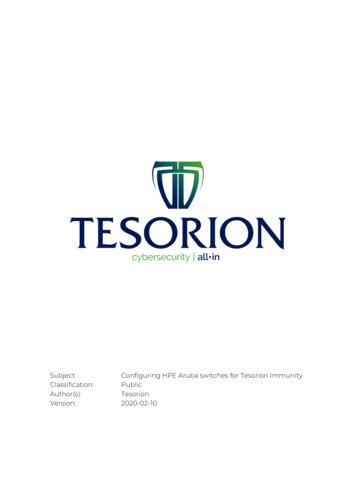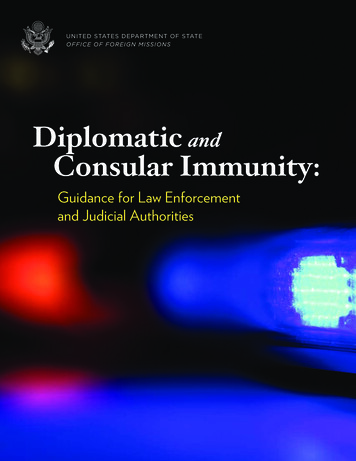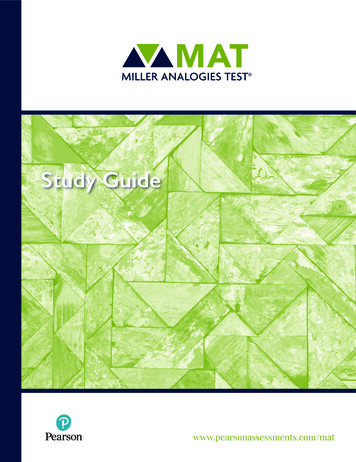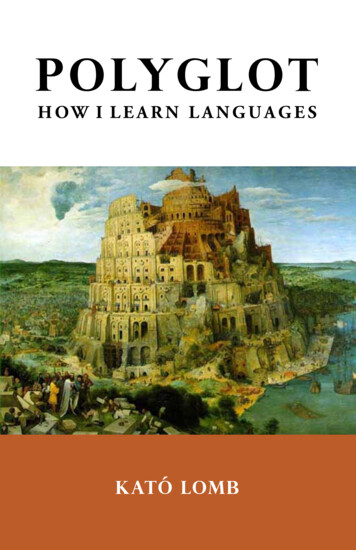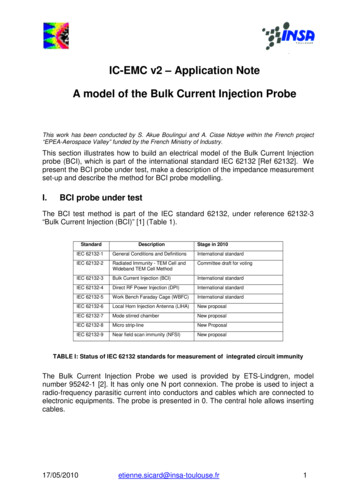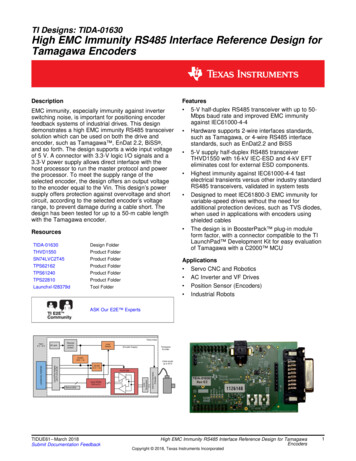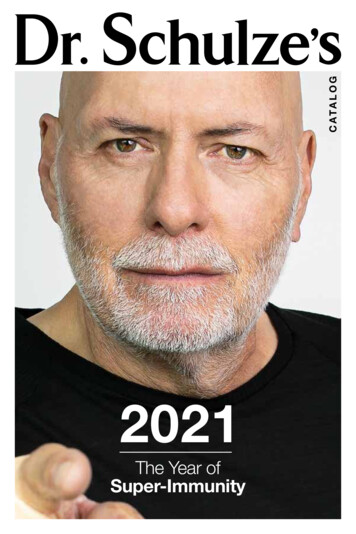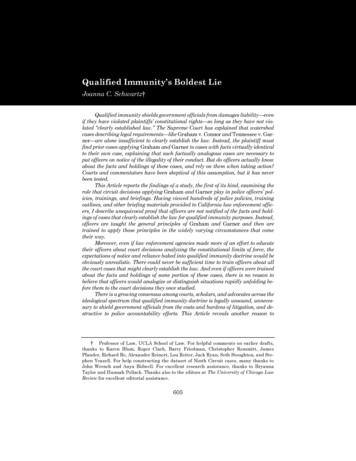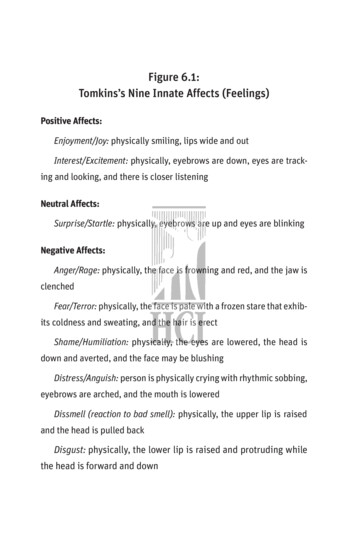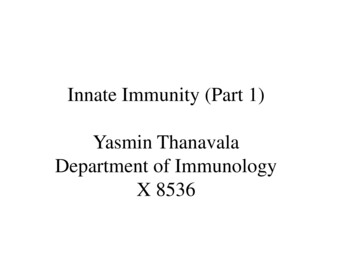
Transcription
Innate Immunity (Part 1)Yasmin ThanavalaDepartment of ImmunologyX 8536
Judy Owen Jenni Punt Sharon Stranford.Kuby ImmunologySEVENTH EDITIONCHAPTER 5Innate ImmunityCopyright 2013 by W. H. Freeman and Company
Innate immunity: most ancient line of defense, someform found in all multi cellular plants and animals.Adaptive immunity : more recent evolutionary andevolved in jawed vertebrates. It complements innateimmunity.
Key Elements of Innate Immunity
Innate and adaptive immune systems have co-evolved andshow a high degree of interaction and interdependence.If innate immune response is poor, the adaptive immuneresponse will be feeble. In other words, recognition by theinnate sets the stage for an effective immune response.Innate system includes: physical/anatomical, chemical andcellular barriers.
Skin and other Epithelial Barriers
Despite these surface barriers and molecules somepathogens have evolved ways to evade immunedefenses.Via fimbriae or pili (made up of pilin protein) the bacteriainteract with glycoproteins or glyolipids only expressedby epithelial cells of the mucous membrane of particularorgans.eg. Influenza virus attaches firmly to respiratory tractcells expressing sialic acid residues of glycosylatedreceptor proteins via its hemagglutinin; N. gonorrhoraeattaches to urogenital tract via its pili but also OPAprotein which helps the bacteria to adhere withincolonies but also adhere to host cells especially thosethat express CEA.
Effectors of Innate Responses to infection
The immune system:1) Senses/detects the presence of a pathogen2) Mounts a response
Sensors: Soluble or membrane bound molecules (receptors)that recognize molecular patterns or motifs absent in the hostbut present in the pathogen.Pattern Recognition Receptors (PRRs) on host cell recognizePathogen Associated Molecular Patterns ( PAMPs).PAMPs: combination of sugars, lipoproteins and some nucleicacid motifs.
Steps in the phagocytosis of a bacterium
The activation of phagocytosis can also occurindirectly by the phagocyte recognizing solubleproteins (called opsonins) that have bound to themicrobes surface thus enhancing phagocytosis.This process is called opsonization (to make tasty).Once opsonins are bound to the surface of themicrobe the are recognized by opsonin receptors onthe phagocyte activating phagocytosis.
Leukocyte Extravasation Rigorously controlled migration of leukocytes fromthe blood into the tissue. Regulated by small molecular mediators, includingchemokines and complement proteins, and by celladhesion molecules.This process will be covered in depth in a later chapter.
Psoriasin (an anti-microbialprotein) prevents colonization ofskin by E.coli.
Human Defensins: Cationic peptide, 29-35 residues, with 6 invariantcysteines that form disulphide bonds stabilizing the peptide into arelatively rigid three dimensional structure. Human defensins kill a variety of bacteria (E.coli, Streptococcuspneumoniae, Pseudomonas aeruginosa, and Hemophilus influenzae),and also attack the envelope of viruses like some herpes viruses andinfluenza virus. Made by paneth cells of the intestine, epithelial cells of the pancreasand kidney. Neutrophils are also a rich source of these peptides. Stored in granuleswhere they kill phagocytosed microbes Defensins kill rapidly, within minutes. Even slowest acting anti-microbial peptide will kill within 90 mins.
Severe fungal infection in a fruit fly: unable to synthesizeantifungal peptide drosomycin
Components of Innate ImmunitySoluble molecules Antimicrobial peptidesCytokinesComplement proteinsAcute phase response proteinsMembrane receptors TLR NOD SR
Cytokines:Cyto cellKinein to moveCytokines bind to specificreceptors on the membraneof target cells triggeringsignal transduction pathways
Cytokines properties: pleiotropy, redundancy,synergy, antagonism and cascade induction
Hallmarks of Acute Local Inflammation Tumor– Swelling Rubor– Redness Calor– HeatDescribed by the Romans 2000 years ago Dolar– Pain Functio laesa– Loss of functionAdded by Galen
Hallmarks of Acute Local Inflammation Swelling– Caused by increased vascularpermeability, accumulation offluid (edema) and extravasation ofleukocytes into the area Redness– Caused by increased blood volume(vasodilation) and platelet leakinginto the area Heat– Caused by increased blood volumePain and loss of function
Local inflammatory response is accompanied by a systemic responseknown as the Acute Phase response. This response is marked by theinduction of fever, increased synthesis of hormones ACTH andhydrocortisone and increased production of leukocytes and theproduction of a large number of proteins by the liver called Acute PhaseProteinsAcute Phase Proteins made during the acute phase of the response toinfection (preceding recovery or death).eg. C-reactive protein levels increase 1000 fold during an acute phaseresponse.complement components (C3, factor B, factor D and properdin),mannose-binding lectin (MBL binds to mannose residues on the surfaceof bacteria, fungi and some viruses) are also acute phase proteins.
A connection between inflammation, the immune system and arterydisease was first suggested from studies in animals fed anartherosclerosis-inducing diet; lots of leukocytes found firmly attached tothe arterial walls.Now it is know that leukocytes are important in the development ofartherosclerotic plaques.Examination of blood levels of inflammatory markers IL-6, TNFα, CRPand the traditional risk markers (cholesterol, LDL, HDL) followed for 68 years in men and women.Of the inflammatory markers only CRP levels were found to beassociated with higher risk of coronary disease.Statins which lower cholesterol levels also lower inflammation. Statinsresult in lowering levels of CRP.
Cell Types of Innate Immunity
Neutrophils First line of defense—first cell type that migrates from the blood to the site ofinfection.Essential for innate immunity against bacteria and fungi.Anti-microbial activity:– Phagocytosis; direct or by opsonization– Oxidative and nonoxidate killing– Oxidative mechanism : reactive oxygen species (ROS) and reactivenitrogen species (RNS)ROS include—superoxide ion O2- , hydrogen peroxide(H2O2), hypochlorusacid (HOCL). ROS generated by the NADPH phagosome oxidase (phox)enzyme complex– Reaction of nitric oxide with superoxide generates RNS– Nonoxidative mechanism: neutrophil granules fuse with phagosomereleasing their anti-microbial peptides/ proteins (bactericidial permeabilityincreasing protein BPI), enzymes (proteases, lysozymes) that help todestroy the pathogenIncreased expression of inducible nitric oxide synthetase (iNOS)
Macrophages Activated by TLR binding to their ligand Activated macrophages exibit:– Increased phagocytosis– Increased respiratory burst– Increased expression of inducible nitric oxidesynthetase (iNOS). iNOS oxidizes L-arginine to Lcitrulline and nitric oxide (NO)– Secrete cytokines IL-1, IL-6, and TNF-α– Produce complement proteins– Express higher levels of MHC class 11 and therebypresent antigens to T cells
NK Cell Critical first line of defense against viralinfections. Can distinguish between an infected and uninfected host cell. By killing the virally infectedhost cell they eliminate source of additionalvirus. Secrete cytokines IFNγ and TNFα- these cytokines stimulate maturation ofdendritic cells.- IFNγ mediates macrophage activation andregulates TH cell development.
Dendritic Cells Critical cells for transition from innate to adaptiveimmunity. Binding of TLRs to recognize pathogens- this stimulates DC activation and maturation(increased production and surface expression ofMHC Class 11 and co-stimulatory molecules).-activated DCs migrate to lymphoid tissue andpresent antigen to TH and TC cells DCs can generate ROS and RNS. Plasmacytoid DCs are potent producers of type 1interferons that block viral replication. Myeloid DCs produce IL12, IL6 and TNF-α, all potentinducers of inflammation.
The immune system:1) Senses/detects the presence of a pathogen2) Mounts a response
Sensors: Soluble or membrane bound molecules (receptors)that recognize molecular patterns or motifs absent in the hostbut present in the pathogen.Pattern Recognition Receptors (PRRs) on host cell recognizePathogen Associated Molecular Patterns ( PAMPs).PAMPs: combination of sugars, lipoproteins and some nucleicacid motifs.
1996: Jules Hoffman and Bruno Lamaitre Cell 86: 973reported that mutations in Toll made the fruit fly highlysusceptible to lethal fungal infection.1997: Ruslan Medzhitov and Charles Janeway showed thatthis pathway conserved between fruit flies and humans. Showedthat a human protein ( TLR4) that they identified by homologyof its cytoplasmic domain and that of Toll when transfected intoa cell line activated the expression of immune response genes.1998: Bruce Beutler mutant mice (lps ) gene encoded a mutantform of TLR4, resistant to fatal doses of LPS.
TLRs Membrane bound receptors Structurally Conserved– Multiple leucine-rich regions in extra cellularregion– Contain conserved TIR (Toll/IL1 receptor) inintercellular domain for signaling.
TLR structure
Function as either hetero or homodimersPairing affects specificityTLR1/2TLR2/6Location reflects ligands:TLRs that recognize extracellular ligands are found on the cellsurfaceTLRs that recognize intracellular ligands are found on theendosome
Innate and adaptive immune systems have co-evolved and show a high degree of interaction and interdependenc
